Menus
- Future is past
- No progress in transmission in 40 years?!
- Performance increase of over 78 percent
- BMW R 1200 RS only 10 kilograms heavier
- BMW R 1200 RS reigning Alpine Master 2015
- Flood of information like in the 7 Series BMW
- Conclusion
- Opinion of the R 100 owner
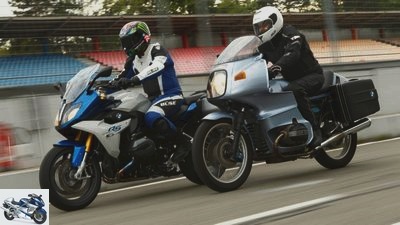
Bilski
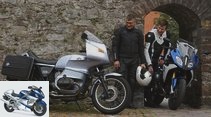
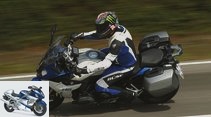
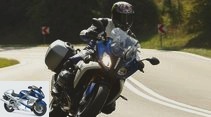
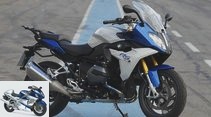
25th photos
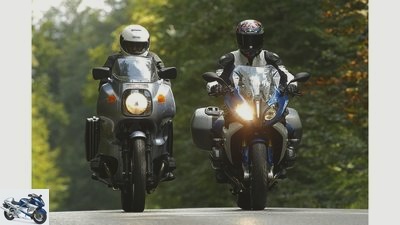
Bilski
1/25
Characteristic to this day: the front of the world’s first series full fairing. In contrast, the new RS looks much more arbitrary.
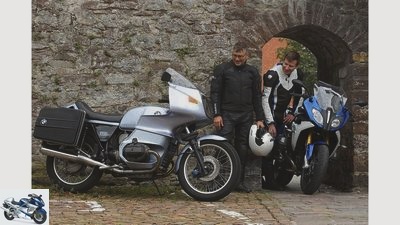
Bilski
2/25
BMW R 100 RS and BMW R 1200 RS.
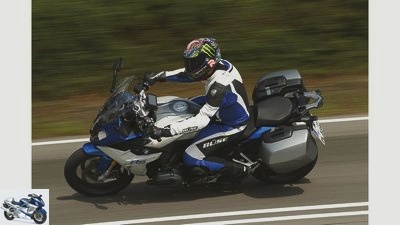
Bilski
3/25
The 1200 is an ideal combination of travel and sport. With a lot of driving dynamics, expensive top equipment, comfortable seating position and great suitcases.
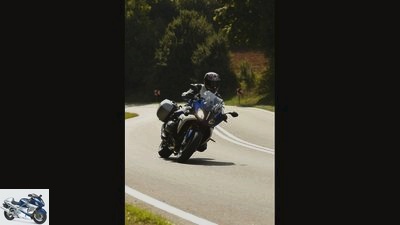
Bilski
4/25
BMW R 1200 RS.
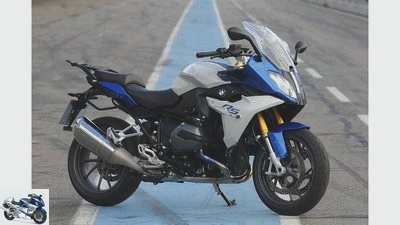
Bilski
5/25
BMW R 1200 RS.
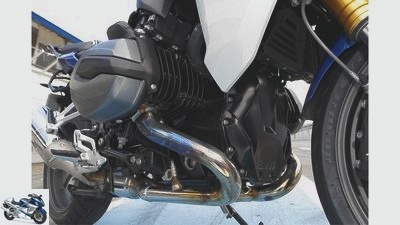
Bilski
6/25
BMW R 1200 RS.
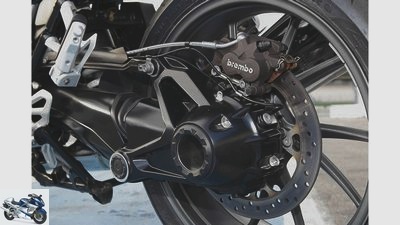
Bilski
7/25
Fat: powerful cardan single-sided swing arm with torque support and a huge, hollow axle.
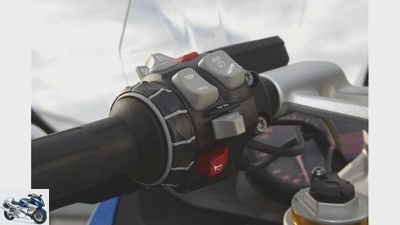
Bilski
8/25
A lot to do for the thumb: operate cruise control, dynamic ESA, traction control and navigation.
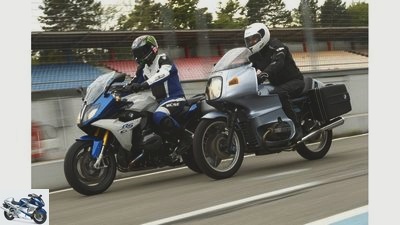
Bilski
9/25
BMW R 100 RS and BMW R 1200 RS.
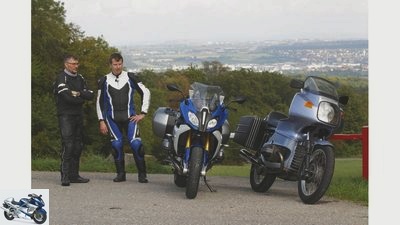
Bilski
10/25
BMW R 100 RS and BMW R 1200 RS.
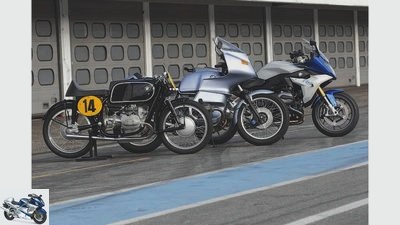
Bilski
11/25
Another era: when the RS 54 was winning laurels, the abbreviation “RS” still stood for “racing sport”, not for “travel and sport”.
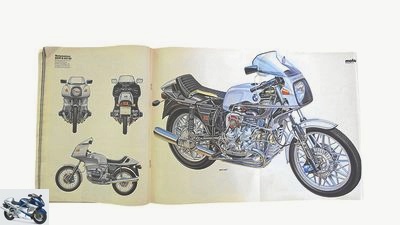
12/25
A sensation on wheels: in 1976 the RS was considered a technological synthesis of the arts. Here as a sectional drawing that can be folded out in “Motor Magazin”; the cast wheels came later.
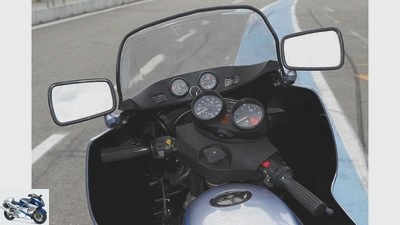
Bilski
13/25
Classic round clocks, narrow handlebars with steering damper and “baffle plate”, crude turn signal switch on the right, closely spaced mirrors.
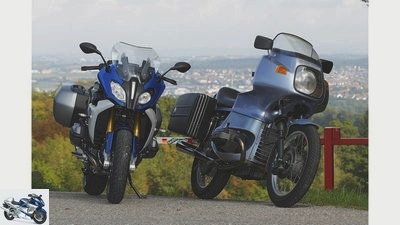
Bilski
14/25
BMW R 100 RS and BMW R 1200 RS.

Bilski
15/25
BMW R 100 RS and BMW R 1200 RS.
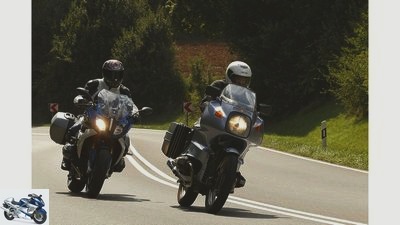
Bilski
16/25
BMW R 100 RS and BMW R 1200 RS.
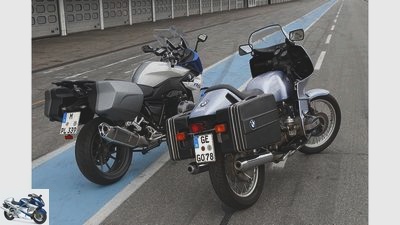
Bilski
17/25
BMW R 100 RS and BMW R 1200 RS.
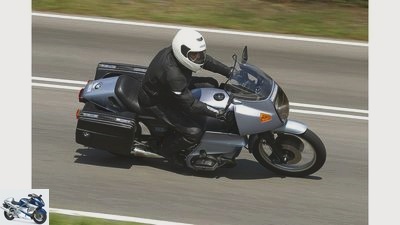
Bilski
18/25
Protected: The full paneling developed in the wind tunnel shields the whole area, the Krauser cases nestle tightly against the rear.
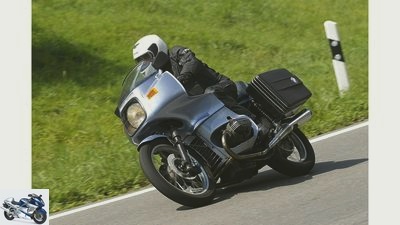
Bilski
19/25
The flush-fitting, wedge-shaped indicators and the 180-millimeter round headlight behind the inclined trapezoidal pane ensure that the fairing is extremely recognizable to this day.
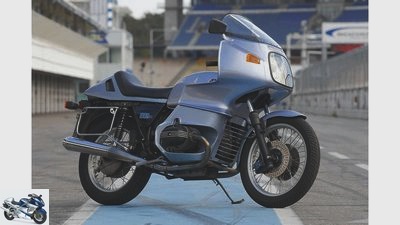
Bilski
20/25
The Über-BMW presented in 1976 was a sensation at the time.
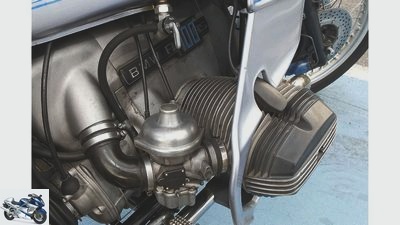
Bilski
21/25
Intuitive experience: gas flow from the air filter housing through the curved intake port, Bing carburettor and cylinder into the manifold; Petrol tap left and right.
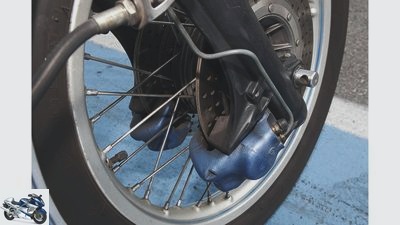
Bilski
22/25
Own: the blue anodized swivel calipers and the master brake cylinder under the tank.
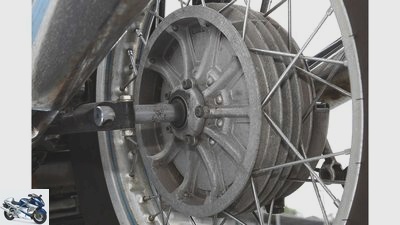
Bilski
23/25
It used to be typical at BMW: drum brakes, spoked wheels and a thin thru-axle.
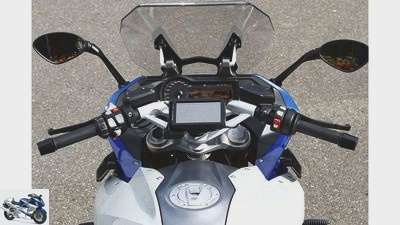
Markus Biebricher
24/25
Everything on it: wide, almost too high handlebars, super-class on-board computer, navigation system on the fork bridge (extra), height-adjustable disc.
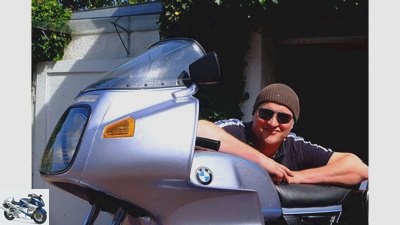
Blacksmith
25/25
Georg Godde (“Cafemoto”) is a BMW lover, refiner and industrial designer.
Impression BMW R 100 RS and R 1200 RS
Future is past
It is considered the most modern and perhaps also the most versatile sports tourer, the BMW R 1200 RS. But even its ancestor, the R 100 RS, was a real milestone in 1976/77: It was not just the first series-produced full fairing on a large-scale motorcycle that made it epoch-making.
MOTORRAD editor Markus Biebricher still remembers the year 1977 when he was 14: “There was an A2 poster from BMW hanging there R. 100 RS above my bed. I looked at the RS in admiration for hours, took it with me into my dreams, and took it on tours in my head after my homework. When I woke up, it made me fit for the day, because for me it was a symbol: that of a safe, solid, sporty motorcycle with a spectacular, harmonious design that protects its rider from wind and weather. ”BMW’s top model at the time impressed. It was a sensation that Über-BMW presented in 1976. Your 980 cubic boxer was the most powerful of the three newly presented 1000s in the / 7 series, only promising 70 hp in the RS. In addition, the first frame-mounted full fairing on a mass-produced motorcycle – the hapless Vincent Black Prince already wore a plastic cover in 1954/55 – 39 years ago the future hit the road.
Buy complete article
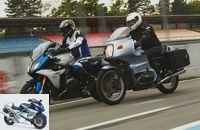
Impression BMW R 100 RS and R 1200 RS
Future is past
New RS rugged, angular, ornate
BMW chief designer Hans A. Muth landed his second stroke of genius. The recognition value of the cladding is enormous to this day: with flush fitted, wedge-shaped indicators and the 180-millimeter round headlight behind the inclined, trapezoidal glass pane. This is timeless, elegant and characteristic design: clear, straightforward, clean. Classic Weinmann spoke rims from the first series go well with this: silver anodized with blue decorative lines. The BMW R 100 RS was planned from the start with filigree cast wheels. But they were only available in good quality from Italy in spring 1977 and cost a full 725 marks extra.
The current BMW R 1200 RS has a completely different effect. Fissured, angular, ornate. And despite the front, which is based on the super sports bike S 1000 RR, with multi-reflector headlights, it can be replaced. Even the optional white-blue-black paint doesn‘t change anything. The eye doesn’t know where to look first, and unlike the BMW R 100 RS, there is nowhere to rest. Here another bead, there another translucent wing … Both RS generations are children of aerodynamics, born and polished in the wind tunnel. What was still exclusive in 1976.
No progress in transmission in 40 years?!
Just opening the two petrol taps on the left and right, they click into the “open” step, is a sensual experience. Take care when getting on: the side stand snaps into place by itself, that’s how it was back then. The easy-to-use choke is on the left under the tank. The old Schlegel wakes up with a bubbling bubbling sound, munching discreetly from the silencers laid on both sides. “Wroumm”, the water boxer wakes up with a motivated bark. The on-board electronics probably lift the exhaust flap a little when starting. Acoustically present, the new engine sounds from the thick, knobbly exhaust. Really true: the idling of the BMW R 100 RS seems more even, the new BMW R 1200 RS sometimes crackles. The valve train of both boxers works audibly ticking.
Both RSs have a slight tilting moment around the longitudinal axis when playing with the throttle, today as an electronic ride-by-wire: They gently rock themselves first to the right and then back to the left into the central position. The historical cable clutch is easier to dose! The BMW R 100 RS is easily forgiven for throwing a cloud of “Aral Ultimate” perfume out of the flat fuel filler cap, the clutch slipping under full load, treacherous idle times between two gears, downshifting requires a hard step. The hydraulic cylinder of the 1200 clutch is digitally engaged, on or off. Only disturbs when moving off, because from around 2500 rpm the optional gearshift assistant allows upshifts and downshifts without using the clutch, and even double-declutching by itself. You only concentrate on braking and turning points, you can completely forget about coupling on the BMW R 1200 RS. If you do, the shift travel is just as long as with the ancestor, the “Kalonk” of the acoustic gear indicator (there is also a digital one in the cockpit) more violent than on the R 100. No progress in the transmission in 40 years?!
Performance increase of over 78 percent
Both boxers can be beefy. But really only the new one. It’s crazy how the 1200er pulls your arms out under 3000 tours. It looks much livelier and more agile, turns freely high. Wow, that is punch that can be perfectly implemented in all six courses. In the final gear steps four and five, the comfortable speed of the slow-revving, high-revving R 100 engine is between 3000 and 5000. It feels like it has a lot more flywheel than its great-great-grandson. Vibrations? Yes, they are noticeable, but never annoying on either. In 1976, the rounded, today so popular “basket” valve covers were suddenly a thing of the past. Now there were angular with cast, horizontal longitudinal ribs. The angular, more powerful oolytes of the water-cooled boxer have short, thick cooling fins – with valve covers as smooth as a child’s bottom. The delightful castle nuts on the distinctive forward-opening bends of the BMW R 100 RS are history. With cooling ribs on the oil pan and air-permeable slots in the front of the plastic skirt. Today there’s an XXL water cooler, that’s that!
Immense: the increase in performance from 70 to 125 hp, an increase of over 78 percent! The displacement grew only moderately across all boxer generations in between: from 980 to 1170 cm3 (plus 20 percent). Currently, four overhead camshafts rotate in the two heads instead of just one amidships below. Instead of long bumpers, they use rocker arms to drive four instead of two valves per cylinder: much larger valve cross-sections require more effective gas changes. Less curved intake paths ensure better flow and filling than the traditional boxer with its compact, short motor housing. Higher speeds are hardly the secret of the power cure – the nominal speed only increased from 7250 to 7750 tours in just under 40 years. The more stable thermal balance of the partially water-cooled cylinders enables closer manufacturing tolerances, shortens the warm-up phase and keeps the combustion chambers cooler. Much higher compression, 12.5 instead of 9.5 to one, gets more power from less fuel! Injection and electronic ignition of the latest generation meter the fuel and control its flaring much more finely than ignition contacts and 40s Bing carburettors were ever able to do.
BMW R 1200 RS only 10 kilograms heavier
You have to get involved in the elevator effect of the BMW R 100 RS: its cardan double-arm swing arm lifts the rear when you accelerate and lets it collapse again when you release the accelerator. You have to be prepared for this in, no, before bends: Shifting, braking and clutching should be completed, the radius should be rounded with an even load in order to gain ground clearance and not leave the targeted line. Here, too, the new one is easier to drive, the torque support on its single-sided swing arm pretty much prevents cardan reactions. At creeping speed, booming noises emanate from the voluminous front of the BMW R 100 RS – resonance vibrations of the multi-part fairing. In the worst-case scenario, only individual parts had to be replaced. You feel wonderfully secure behind her broad hamster cheeks. In the city, a lot of weight rests on the wrists, due to the heavily cranked handlebars, which are only 60 centimeters wide. The knees are tight against the narrow but long 24-liter tank. And the lower legs on the Bing carburetors. The closely standing mirrors actually only show your own upper arms.
The 1.5-person bench, which is not overly wide and quite short, is comfortably upholstered. In Germany, the BMW R 100 RS was never approved for two-person operation; Optionally, there was the longer bench of the officially 65 HP strong R 100 S. Including the six kilogram Krauser suitcase and its carriers, the 244 kilogram RS (that was very little for its time!) allowed a load of only 154 kilograms anyway. It’s sensational how tight the suitcases nestle against the rear, 73 centimeters wide! Sitting on the BMW R 1200 RS is also very comfortable, leaning forward slightly for sports and tourism. Your handlebars are almost too much towards you, with sporty driving you want to intuitively put more load on the front wheel. When fully equipped, the 1200 weighs 254 kilograms, just ten kilograms more than before. Only today’s suitcases hold one helmet each. The rear seat and payload are much larger (196 kilograms). The BMW R 100 RS shows the trump card of its perfectly shielding cladding on the motorway. The driver sits fantastically integrated – without turbulence and almost without suction. As soon as you make yourself even a little small, there is complete calm. But that doesn’t bring more top speed. A lot of travel, some sport.
BMW R 1200 RS reigning Alpine Master 2015
From 140 to 160, a gentle stir goes through the old beams. The downforce-generating fairing was designed for high-speed stability. For 1976 that was great! The Japanese wobbled very differently. As wrote MOTORRAD 3/1977: “With this BMW R 100 RS, travel averages have been achieved that no other test machine has ever allowed.” 160 as constant speed! The comfort is absolutely okay, the fork responds really well for its time, just rebounds a little quickly. The Ikon struts, Australian replicas of legendary Konis, also work really well. And Bridgestone BT 45 have been top tires for all youngtimers since 1999! Krude: the BMW turn signal switch from the 70s. It sits in the right handlebar fitting, it flashes left upwards and right downwards. The main thing is different. A cable (!) Goes from the hand brake lever to the master brake cylinder under the tank. Only from there do hydraulic lines lead to the pivoting saddles. Feedback and effect get stuck somewhere, feels more like a powerful drum brake. It is precisely this in the rear wheel that must provide valuable support.
In contrast, the BMW R 1200 RS is a messenger from the future. It runs like clockwork even at Tacho 230. If you have raised the small, effective disc without tools using the clever parallelogram mechanism, you hardly need to hide. The R 1200 RS finds the right course telepathically. Despite wider tires – today there is more rubber in the front than there was in the back – which require more lean angle at the same speed: The new one drives circles around the old one as the reigning Alpenmaster 2015. The semi-active chassis increases the compression damping at the front when braking, an electronic anti-dive. The directly linked central spring strut extends short, hard impacts a little dry. Lots of sport, lots of travel! If you pull on the thin, insensitive brake lever of the 1200, all three discs bite together. It’s not a stick in the spokes, it’s a square piece of wood! In bends or when turning, you can also use the pedal to brake specifically at the rear. Ingeniously simple. Forty years ago, no one dared to dream of traction control and anti-lock devices on the wheels.
Flood of information like in the 7 Series BMW
The “On-Board Computer Pro” of the BMW R 1200 RS offers a wealth of information and display functions like a BMW seven-series. It automatically switches to “night view” at dusk and in tunnels, and the daytime running lights to low beam. In addition, the computer on the wheels gives upshift recommendations and adapts the red area to the current engine temperature. “Keyless go” only locks the tank lock and ignition / steering lock with a transponder, without a key. Will the RS jack itself up at the push of a button in 40 years??
Today the indicator switch is conventional, the stands are easier to reach from any position, and getting on and off is easier than with the R 100 RS. Now everyone can. A whopping 11,210 marks (without suitcase) in 1977 corresponded to almost exactly eight average monthly wages. Even not cheap 18,610 euros in full equipment are statistically compared to around 3500 euros gross per month. The future, it was once.
Conclusion
The 1976 BMW R 100 RS was a very modern and bold construction. At the transition from the metal to the plastic age, the large, characteristic full cladding gave it a real aura. Anyone who drives it today will have an inkling of how progressive this driving behavior was back then. But he also has to get involved much more with the more sensitive technology. In direct comparison, it is hard to believe how much better and more user-friendly today’s machines are. Especially since the R 1200 RS, full of technology, is one of the best motorcycles of its time – just like its ancestor. So a real keeper of tradition.
Opinion of the R 100 owner
Blacksmith
Georg Godde (“Cafemoto”) is a BMW lover, refiner and industrial designer.
Georg Godde from Gelsenkirchen (47) is the owner of this 77-series BMW R 100 RS and an industrial designer himself (0815design.de). At the age of 19 he already had his first BMW, an R 60/5, which is waiting to be restored in the cellar of a good friend. In addition, Georg and his brother Michael currently have around a dozen BMWs with a focus on the 1970s and 1980s. Some are in their original condition, others Georg rebuilt according to his own ideas together with his partner Holger Maninger under their label “Cafemoto”, which MOTORRAD has reported on several times. In the “FUEL” issue 4 is a workshop portrait of “Cafemoto”, the BMW forge from the Ruhr area.
Godde’s opinion on the BMW R 100 RS: “This is still a timeless, functional design in perfection, because form and function are in harmony. For me, it’s the full fairing par excellence, a real milestone in motorcycle design. I take my hat off to Hans A. Muth as the designer of this motorcycle. Unfortunately, the R 100 RS is clearly undervalued in the shadow of the R 90 S – which Hans A. Muth also designed. ”Anyone who wants to discuss this with Georg Godde can contact him at info@cafemoto.de
Related articles
-
Manix Impression Yamaha XJ 900 N As before An encounter with the ex: Editor Thomas Schmieder had the opportunity to repeat exactly that Yamaha XJ …
-
Premiere: Aprilia Dorsoduro 1200
Aprilia Premiere: Aprilia Dorsoduro 1200 The powerful Aprilia Dorsoduro 1200 introduces itself Content of Even those who don’t believe in occultism and…
-
Artist Top test BMW R 1200 R Double whopper Classic, but modern. Cruise casually or alternatively drive sportily? Two hearts beat in the new BMW R 1200…
-
Top test: Yamaha XT 1200 Z Super Tenere
Bilski 23 photos Yamaha 1/23 The wheel speed sensors for ABS and traction control receive their signals from radially mounted rings. Yamaha 2/23 In the…
-
Double top test BMW R 1200 GS-R 1150 GS
fact double top test BMW R 1200 GS / R 1150 GS Beautiful view Cheeky to whet corners, dust quickly through the terrain, travel comfortably, arrive safely …
-
Flash Art 26 pictures Flash Art 1/26 The Indian FTR 1200 S has to prove in the test what it’s really made of. Flash Art 2/26 193 km / h, more lets the …
-
On the move with Sauerborn-Munch TTS 1200 Turbo and support BMW K 100 RS Turbo
Jacek Bilski 21st photos Jacek Bilski 1/21 In the early 1980s, the Japanese thought that turbochargers would go best with small engines. Two German…
-
Test BMW R 1200 GS Adventure with ASC
Artist Test BMW R 1200 GS Adventure with ASC Ah! Traction BMW played a pioneering role in the introduction of ABS. Now the Munich-based company is…
-
Presentation of the BMW R 1200 RT and R 1200 ST
BMW Presentation of the BMW R 1200 RT and R 1200 ST Drums The Bavarian boxers strike a double blow: First, the new R 1200 RT appears, the production…
-
BMW R 1200 RT and Triumph Trophy 1200 SE in comparison
comparison test: top tourers from BMW and Triumph BMW R 1200 RT and Triumph Trophy 1200 SE in comparison The plan, in three days mountains, sea and …